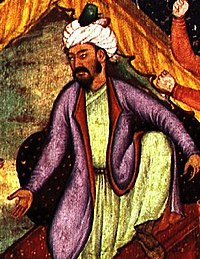바부르: 두 판 사이의 차이
보이기
내용 삭제됨 내용 추가됨
잔글편집 요약 없음 |
편집 요약 없음 |
||
| 1번째 줄: | 1번째 줄: | ||
[[파일:Babur.jpg|200px|thumb|바부르의 초상]] |
[[파일:Babur.jpg|200px|thumb|바부르의 초상]] |
||
'''자히르 알딘 무함마드 바부르'''([[우르두어]]: ظہیرالدین محمد بابر, [[힌두어]]: ज़हीरुद्दीन मुहम्मद बाबर. [[1483년]] 2월 23일[율리우스력으로는 2월 14일] - [[1531년]] 1월 5일[율리우스력으로는 1530년 12월 26일])는 [[안디잔]](지금의 [[우즈베키스탄]]의 한 지방) 출신의 모험가로, 여러 차례 실패를 경험했으나, 1504년, 결국 [[아프가니스탄]]의 [[카불]]에서 왕국을 세우는데 성공했다. 그곳에서 그는 군대를 모아 1526년까지 인근 지역을 정복하고, 이후 [[로디 왕조]]를 공격하고 약탈해 [[무굴 제국]]의 기초를 쌓았다. 그의 자서전이 남아 있다. <ref>{{글로벌2}}</ref> |
|||
| ⚫ | |||
| ⚫ | 바부르는 아버지를 통해 [[티무르]]의 피를 이어받았고, 그의 어머니를 통해 [[칭기즈 칸]]의 피를 이어받았다<ref>[[브리태니커 백과사전]]의 [http://www.britannica.com/eb/article-9054153 Mughal Dynasty]</ref>. 바부르의 혈통은 티무르와 차가타이-투르크계에 속했으나, 주변의 환경, 문화, 교육 등은 페르시아 문화의 영향을 많이 받았기에 그는 그 문화를 존중했고, 이는 페르시아 문화가 인도아대륙에 전파되는 계기가 되었다. 또, 페르시아 문화는 그로 하여금 휼룡한 문학적, 예술적 기질과 사료 편찬 기술을 갖추게 해주었다.<ref name="Iranica">{{cite encyclopedia |last=Lehmann |first=F. |url=http://www.iranica.com/newsite/index.isc?Article=http://www.iranica.com/newsite/articles/unicode/v3f3/v3f3a066.html |title= Memoirs of Zehīr-ed-Dīn Muhammed Bābur |encyclopedia=[[Encyclopaedia Iranica]] |accessdate=2008-04-02 |quote=His origin, milieu, training, and culture were steeped in Persian culture and so Babor was largely responsible for the fostering of this culture by his descendants, the Mughals of India, and for the expansion of Persian cultural influence in the Indian subcontinent, with brilliant literary, artistic, and historiographical results. }}</ref><ref>Robert L. Canfield, Robert L. (1991). ''Turko-Persia in historical perspective'', Cambridge University Press, p.20. "The Mughals-Persianized Turks who invaded from Central Asia and claimed descent from both Timur and Genghis - strengthened the Persianate culture of Muslim India".</ref> |
||
그는 [[중앙아시아]]에서 [[아프가니스탄]]을 거쳐 [[인도]]에 침입, [[델리]] 지방을 점령하고 [[벵골]]에 이르는 북인도 지방을 통일하였다. 그의 자서전이 남아 있다. <ref>{{글로벌2}}</ref> |
|||
[[후마윤]]은 그의 부황 바부르를 1530년에 22세에 계승하였다. |
[[후마윤]]은 그의 부황 바부르를 1530년에 22세에 계승하였다. |
||
2011년 6월 15일 (수) 18:40 판

자히르 알딘 무함마드 바부르(우르두어: ظہیرالدین محمد بابر, 힌두어: ज़हीरुद्दीन मुहम्मद बाबर. 1483년 2월 23일[율리우스력으로는 2월 14일] - 1531년 1월 5일[율리우스력으로는 1530년 12월 26일])는 안디잔(지금의 우즈베키스탄의 한 지방) 출신의 모험가로, 여러 차례 실패를 경험했으나, 1504년, 결국 아프가니스탄의 카불에서 왕국을 세우는데 성공했다. 그곳에서 그는 군대를 모아 1526년까지 인근 지역을 정복하고, 이후 로디 왕조를 공격하고 약탈해 무굴 제국의 기초를 쌓았다. 그의 자서전이 남아 있다. [1]
바부르는 아버지를 통해 티무르의 피를 이어받았고, 그의 어머니를 통해 칭기즈 칸의 피를 이어받았다[2]. 바부르의 혈통은 티무르와 차가타이-투르크계에 속했으나, 주변의 환경, 문화, 교육 등은 페르시아 문화의 영향을 많이 받았기에 그는 그 문화를 존중했고, 이는 페르시아 문화가 인도아대륙에 전파되는 계기가 되었다. 또, 페르시아 문화는 그로 하여금 휼룡한 문학적, 예술적 기질과 사료 편찬 기술을 갖추게 해주었다.[3][4]
후마윤은 그의 부황 바부르를 1530년에 22세에 계승하였다.
| 전임 - |
제1대 인도 무굴 제국 황제 ~1530년 |
후임 아들 후마윤 |
주석
- ↑ 《글로벌 세계대백과사전》
- ↑ 브리태니커 백과사전의 Mughal Dynasty
- ↑ Lehmann, F. 〈Memoirs of Zehīr-ed-Dīn Muhammed Bābur〉. 《Encyclopaedia Iranica》. 2008년 4월 2일에 확인함.
His origin, milieu, training, and culture were steeped in Persian culture and so Babor was largely responsible for the fostering of this culture by his descendants, the Mughals of India, and for the expansion of Persian cultural influence in the Indian subcontinent, with brilliant literary, artistic, and historiographical results.
- ↑ Robert L. Canfield, Robert L. (1991). Turko-Persia in historical perspective, Cambridge University Press, p.20. "The Mughals-Persianized Turks who invaded from Central Asia and claimed descent from both Timur and Genghis - strengthened the Persianate culture of Muslim India".
| 이 글은 군주에 관한 토막글입니다. 여러분의 지식으로 알차게 문서를 완성해 갑시다. |
